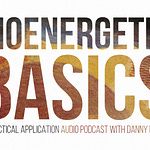Advertisements
📝 Bioenergetic Basics 6-Part Crash Course:
• Patreon: https://bit.ly/bbcoursepat
• Gumroad: https://bit.ly/bbcoursegum
🗣️ One-to-One & Group Coaching:
https://www.patreon.com/dannyroddy
Timestamps
00:00 - Intro
00:39 - My experience with sleep problems, sleeping is a “high-energy” activity
01:50 - Restricting protein before bed (avoiding hypoglycemia)
02:33 - Calcium to phosphorus ratio (to lower parathyroid hormone, etc.)
03:03 - Solving constipation or diarrhea
04:13 - Grounding as a way to protect from stimulating EMF (https://bit.ly/3SsnCyS)
05:26 - Vitamins D and K2 before bed (in olive oil)
06:18 - Aspirin
07:17 - Red incandescent lights around your work space
07:44 - Solving hypothyroidism, T3 to T4 ratio
08:30 - Progesterone (Progest-E) and DHEA
08:47 - Antihistamines (cyproheptadine and lidocaine)
09:39 - Overcoming grogginess (keep the blood sugar up and the inflammation low)
10:06 - Nighttime wake-ups (hypoglycemia, adrenaline
10:34 - Advertisement: Bioenergetic Basics 6-Part Crash Course
Selected References:
Szent-Györgyi, A. The Living State: With Observations on Cancer. (1972)."The role of ATP is not limited to the contraction cycle. It dominates the physical state of muscle even in rest, keeping it soft and pliable, keeping actomyosin dissociated. I have shown, with Borbiro (Borbiro and Szent-Györgyi,1949), that rigor mortis is but a lack of ATP..."
Picard, M., et al. Mitochondrial functions modulate neuroendocrine, metabolic, inflammatory, and transcriptional responses to acute psychological stress. PNAS November 16, 2015. "Central to stress adaptation is cellular energetics, involving mitochondrial energy production and oxidative stress. We therefore hypothesized that abnormal mitochondrial functions would differentially modulate the organism’s multisystemic response to psychological stress.”
National Academies of Medicine. Dietary Reference Intakes for Energy, Carbohydrate, Fiber, Fat, Fatty Acids, Cholesterol, Protein, and Amino Acids (2005) "Not only must sufficient protein be provided, but also sufficient nonprotein energy (i.e., carbohydrates, fats) must be available so that the carbon skeletons of amino acids are not used to meet energy needs.” (Duffy et al., 1981).
Stearns G. Human requirement of calcium, phosphorus and magnesium. J Am Med Assoc. 1950 Feb 18;142(7):478-85. "All protein-rich foods are good sources of phosphorous." "...The amount of calcium in the diet should equal or exceed the amount of phosphorous…"
Spiller, R. Serotonin, inflammation, and IBS: fitting the jigsaw together? J Pediatr Gastroenterol Nutr. 2007 Dec;45 Suppl 2:S115-9."Clinical conditions with an inflammatory basis, such as coeliac and Crohn disease, also are characterised by excess postprandial serotonin release. Several studies report evidence of low-grade inflammation in IBS with diarrhoea. However, reliable markers of low-grade inflammation that may predict response to serotonin antagonists or other anti-inflammatory agents remain a goal for future research."
Dzoljic MR. Prostaglandins and sleep. Awaking effect of prostaglandins and sleep pattern of essential fatty acids deficient (EFAD) rats. Prostaglandins [1978, 15(2):317-324] “Intraventricular (i.vc. )administration of PGE1, PGE2 and PGF2alpha increased wakefulness without a significant alteration of REM sleep.”
Shen L, Shen J, Pu J, He B. Aspirin attenuates pulmonary arterial hypertension in rats by reducing plasma 5-hydroxytryptamine levels. Cell Biochem Biophys. 2011 Sep;61(1):23-31. "Aspirin is a well-known cyclooxygenase inhibitor that controls platelet release of 5-HT by restraining platelet activation and interaction. Because 99% of whole-blood 5-HT is contained in platelets, the plasma 5-HT levelis dependent upon 5-HT released from platelets."
Esposito, M.G., et al. Parathyroidectomy improves the quality of sleep in maintenance hemodialysis patients with severe hyperparathyroidism. J Nephrol. 2008 Mar-Apr;21 Suppl 13:S92-6."Sleeping disorders are very common in patients with chronic kidney disease on dialysis (CKD5D) and are an emerging risk factor able to predict mortality. Parathyroid hormone (PTH) although considered a pivotal uremic toxin has rarely been associated with sleep disorders in uremia.” "The study indicates that insomnia in patients with severe hyperparathyroidism on maintenance hemodialysis is ameliorated by parathyroidectomy."
Carpenter AC, Timiras PS. Sleep organization in hypo- and hyperthyroid rats. Neuroendocrinology. 1982 Jun;34(6):438-43. “Our findings indicate that adequate levels of thyroid hormone are necessary to sustain extended periods of slow wave sleep in the adult rat while hyperthyroid animals show no disruption of sleep organization.”
Tokunaga, S., et al. Effects of some H1-antagonists on the sleep-wake cycle in sleep-disturbed rats. J Pharmacol Sci. 2007 Feb;103(2):201-6. “In conclusion, cyproheptadine can be useful as a hypnotic, having not only sleep inducing-effects, but also sleep quantity- and quality-increasing effects.”
Haas H, et al. Histamine in the nervous system. Physiol Rev. 2008 Jul;88(3):1183-241. The sedative “side effects” of antihistamines (68) triggered early work and suggestions for histamine as a “waking substance.” "Mutual interactions with other transmitter systems form a network that links basic homeostatic and higher brain functions, including sleep-wake regulation, circadian and feeding rhythms, immunity, learning, and memory in health and disease."



















Bioenergetic Basics #5: Troubleshooting Sleep Problems (Grogginess, Insomnia, Nighttime Wake-Ups)